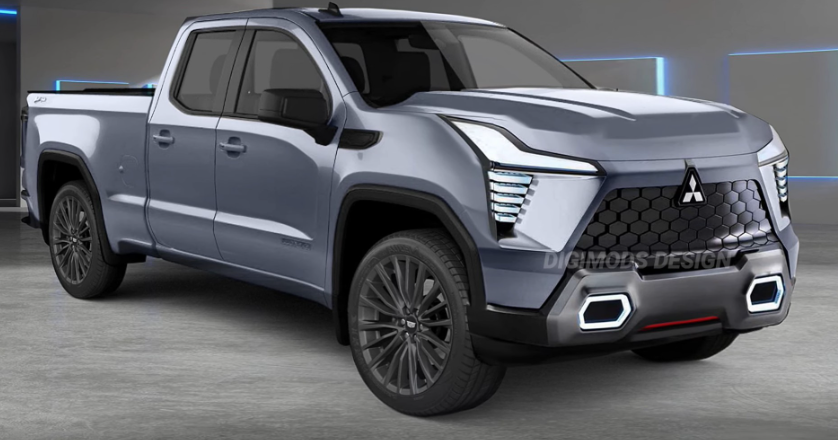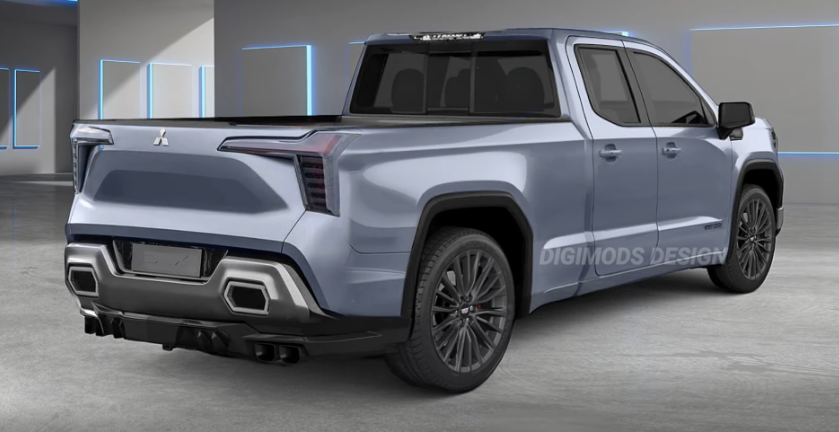Electrifying the Future: The 2025 Mitsubishi Triton Unveiled – Powering Up Pickup Trucks!
KEY TAKEAWAYS:
- Mitsubishi is developing an electrified version of the Triton.
- The specific electrification approach is yet to be decided.
- A battery-electric variant is likely to be the first option.
- The Triton EV maintains the basic sheet metal of previous models.
- Aerodynamic enhancements include a blanked-off grille and drag-reducing wheel covers.
- Challenges include weight, driving range, towing capacity, and payload.
- The initial Triton BEV may target fleet buyers and comply with increasing regulations.
- Mitsubishi sees BEVs as a better fit for pickup trucks compared to PHEVs.
- The combustion-engined Triton is set to launch later this year.
- The Triton BEV is expected to arrive by 2025, with a potential PHEV version in the future.
- Upgrades for the 2025 Triton include a larger intercooler and a four-cylinder turbodiesel engine.
- Hybrid powertrain options are being considered, with the Triton Hybrid featuring two electric motors.
- Transmission advancements include a 7-speed automatic gearbox.
- The Triton will retain its 4×4 capability.
- The price of the 2025 Triton is expected to be higher than the current model.
- Official images of the new Triton will be unveiled soon, with sales to follow.
2025 Mitsubishi Triton: Unveiling the Electrified Future of a Power-Packed Ute
The automotive industry is abuzz with anticipation as Mitsubishi prepares to revolutionize the pickup truck segment with its electrified version of the Triton. In an exclusive interview, we sat down with Mitsubishi’s top powertrain and product managers to extract every detail about this electrifying endeavor. Brace yourself for an electrified future that promises to reshape the landscape of pickup trucks.
Electrification Plans: A Battery Electric Variant Takes the Lead
The pickup BEV is a version of Triton, with plans to electrify the pickup truck in the future.
Takashi Shirakawa, the General Manager of EV Powertrain Engineering, left us with no doubts about Mitsubishi’s commitment to electrification. He confirmed that an electrified version of the Triton is currently under development, though the precise electrification approach has yet to be finalized. However, a battery-electric variant is likely to take the lead.
As Shirakawa explains, “Consider the pickup BEV as a version of the Triton. While we can’t produce an overwhelming number of vehicles due to our company’s size, we do have a solid plan to electrify the pickup truck in the future. Whether we’ll call it the Triton is still under consideration.”
The Electrified Design: Aerodynamic Enhancements for Efficiency
Visualizing the Triton EV is a treat for the eyes, with its sleek and dynamic design retaining the beloved characteristics of its predecessors. The concept images showcase aerodynamic detailing that includes a predominantly blanked-off grille, a streamlined sports bar, and drag-reducing wheel covers. These enhancements not only enhance the vehicle’s aesthetic appeal but also contribute to improved efficiency.
Challenges on the Electric Frontier: Range, Towing Capacity, and Payload
Weight, driving range, towing capacity, and payload are key challenges in developing an electric Triton.
Building a battery-powered utility vehicle presents unique challenges, and weight is one of the primary concerns. To gain traction with private buyers, an electric Triton must offer a minimum driving range of 500 kilometers, a load-lugging capability of approximately 3000 kilograms for braked towing, and a payload of around 1000 kilograms.
Interestingly, the initial Triton BEV may not specifically target recreational ute owners. Shirakawa indicates that fleets and increasing regulations are driving the demand. Australian mining companies, for instance, have already begun trials with BEV utes, including the electrified 70 Series, the LDV eT60, and SEA Electric’s converted HiLuxes and Rangers.
It’s crucial to note that while Mitsubishi holds a significant position in Australia, it faces stiff competition from giants like Nissan, Subaru, and Suzuki in its domestic market of Japan.
2025 Mitsubishi Triton BEV vs. PHEV: Why Battery Electric Prevails
While plug-in hybrid (PHEV) technology remains a possibility, Mitsubishi sees battery electric vehicles (BEVs) as the more suitable fit for pickup trucks. Koichi Namiki, the General Manager of the Product Strategy Division at Mitsubishi Motor Corporation, explains the rationale: “Some fleet companies, as you might know, require battery EVs—pure electric models. We recognize the demand for BEVs, but for PHEV pickup trucks, the demand is currently limited. Although we may develop a PHEV version for frame-based vehicles in the mid-term plan, it is currently excluded.”
The Roadmap Ahead: Combustion Triton and the Electrified Future
The combustion-engined Triton is set to launch this year, with the Triton BEV expected by 2025.
While the combustion-engined Triton is scheduled for market launch by the end of this year, Mitsubishi’s mid-term plan hints at the arrival of the Triton BEV by 2025, which seems increasingly likely. The PHEV version, with potential performance aspirations under the Ralliart badge, is positioned as a more distant prospect.
As a Mitsubishi Australia spokesperson assures, “We eagerly anticipate sharing further details about the development process, Australian range, specifications, timings, and pricing of this next-generation utility vehicle with our valued customers.”
Unveiling the Enhanced 2025 Mitsubishi Triton: Powertrain and Performance
The 2025 Triton will feature a larger intercooler and a four-cylinder turbodiesel engine as standard.”
Beneath the Triton’s robust exterior lies a range of notable upgrades for the 2025 model. Mitsubishi is equipping the next-gen Triton with a larger intercooler behind the front fascia. Furthermore, a four-cylinder turbodiesel engine will come as standard, complemented by new brakes and other improved mechanics. While specific power figures remain undisclosed, improved fuel economy is expected.
However, the true highlight lies in the hybrid powertrain options. Mitsubishi is planning either a mild-hybrid or plug-in hybrid system. The burning question revolves around whether the brand will pair an electric motor with a diesel or gasoline engine. Reports suggest that the Triton Hybrid model will feature two electric motors, a configuration that will enable compliance with global CO2 regulations. With the development of larger batteries, the Triton should offer an impressive driving range. Mitsubishi has confirmed that the hybrid powertrain will be optional and will be developed in collaboration with Nissan and Renault.
Transmission Advancements: Stepping Up to a 7-Speed Automatic
As for the transmission, Mitsubishi is bidding farewell to the 6-speed gearbox and introducing a more reliable 7-speed automatic transmission. However, it is important to note that rival offerings currently feature 8-speed or 10-speed units. Nonetheless, the Triton will retain its impressive 4×4 capability, likely as an optional feature.
2025 Mitsubishi Triton Looking Ahead: Release Date and Price Expectations
As of now, the Triton model is available at an approximate starting price of $30,000, with higher-end variants reaching nearly $60,000. While the exact pricing for the 2025 Mitsubishi Triton remains uncertain, it is reasonable to anticipate a price increase compared to the outgoing model, considering the anticipated enhancements and electrification. Mitsubishi has promised to unveil the first official images of the new Triton in the coming months, with sales expected to commence shortly after.
Unveiling the Electrified Future: Key Highlights of the 2025 Mitsubishi Triton
| Topic | Summary |
|---|---|
| Electrification Plans | Mitsubishi is developing an electrified version of the Triton, with a battery-electric variant being the primary focus. |
| The Electrified Design | The Triton EV maintains the previous model’s sheet metal but incorporates aerodynamic enhancements for improved efficiency. |
| Challenges on the Electric Frontier | Weight, driving range, towing capacity, and payload are significant challenges in developing an electric Triton. |
| BEV vs. PHEV | Battery electric vehicles (BEVs) are considered a better fit for pickup trucks, given demand from fleet companies, compared to plug-in hybrid electric vehicles (PHEVs). |
| The Roadmap Ahead | The combustion-engined Triton is set to launch soon, while the Triton BEV is expected to arrive by 2025. |
| Unveiling the Enhanced 2025 Mitsubishi Triton | The 2025 Triton will feature a larger intercooler and a standard four-cylinder turbodiesel engine, with potential hybrid powertrain options. |
| Transmission Advancements | Mitsubishi is upgrading to a more reliable 7-speed automatic transmission for the 2025 Triton. |
| Looking Ahead | The 2025 Mitsubishi Triton is anticipated to have a higher price than the current model, with official images and sales expected in the near future. |


